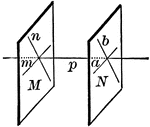
Parallel To Straight Line Construction
Illustration used to show how to draw a straight line parallel to a straight line through a given point.

Construction Of Dividing A Line
Illustration used to show how to divide a given straight line into required number of equal parts.

Construction Of Dividing A Line
Illustration used to show how to divide a given straight line into required number of equal parts.

Construction Of Angle On Straight Line
Illustration used to show how to "draw a straight line through any given point on a given straight line…
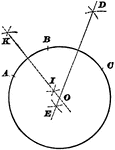
Construction Of Circumference
Illustration used to show how to pass a circumference through any three points not in the same straight…
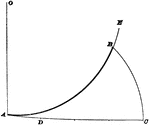
Construction Of Arc
Illustration used to show how to "find an arc of a circle having a known radius, which shall be equal…
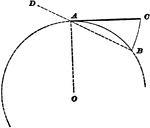
Construction Of Line Equal To Arc
Illustration used to show how to find a straight line of the same length as a given arc of a circle.

Circle Inside Concentric Rectangles
Illustration of a circle inside of 2 concentric rectangles whose vertices are connected by line segments.

Line Perpendicular To Plane
"If a straight line is perpendicular to each of two straight lines at their point of intersection it…

Plane Perpendicular To Line
"All the perpendiculars to a straight line at the same point lie in a plane perpendicular to the line."

Perpendicular To Line In Plane
"If from the foot of a perpendicular to a plane a straight line is drawn at right angles to any line…
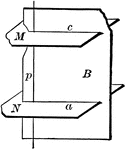
3 Intersecting Planes
Illustration of three intersecting planes. "The straight line perpendicular to one of two parallel lanes…
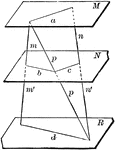
3 Parallel Planes
"If two straight lines are cut by three parallel planes, the corresponding segments are proportional."
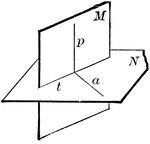
Perpendicular Planes
"If two planes are perpendicular to each other, a line in one of them perpendicular to the intersection…

Plane Passed Perpendicular To A Given Plane
"Through a given line oblique to a plane, one, and only one plane, can be passed perpendicular to the…
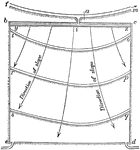
Irrigation by Furrows
One way to spread water over a hillside field, "f m is the main ditch and the slope of the hill as shown…
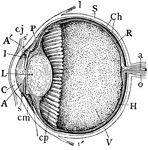
Median Vertical Anteroposterior Section of Eye
"Human Eye, in Median Vertical Anteroposterior Section. (Ciliary processes shown, through not all lying…
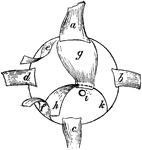
Right Eyeball of Bird
"Right Eyeball of Bird, seen from behind, showing the following muscles; a, rectus superior; b, rectus…
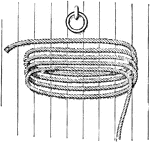
Rope Coiled in Fakes on Deck
"Fake. Naut., one of the circles or windings of a cable or hawser as it lies in a coil; a single turn…

Domestic Cat Skull
"Skull of Cat (Felis catus), showing the following bones, viz. : na, nasal; pm, premaxillary; m, maxillary;…
Progressive Overlap of Shore
Natural and columnar sections at each end and at the center of a line 100 miles long and at right angles…

Clastic Deposits in the Sea
Natural and columnar sections at each end and in the center of a line 100 miles long and extending at…

Inclined Strata Dip and Strike
Diagram illustrating the relationships of dip and strike of the inclined strata of an outcropping series…

Fault Line Valley
A fault line valley. A fault line, is a planar fracture in rock in which the rock on one side of the…
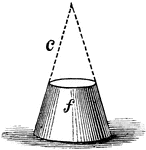
Frustum of a Cone
"The part of any solid between two planes, which may be either parallel or inclined to each other: as,…
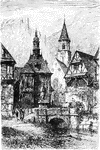
Black Forest Village
View of a village in the Schwartzwald, or Black Forest. The Black Forest stands in the elbow formed…
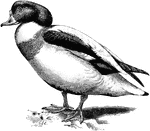
Shelduck
Tadorna cornuta, the Sheld-Drake or Bargander, ...shews a white collar on the lower neck followed by…

Weston Coat of Arms
"The male figure is that of Sir John de Weston, of Weston-Lizars, in Staffordshire, and Isabel his wife,…

Area of Surface Generated by a Straight Line
Diagram used to prove the theorem: "The area of the surface generated by a straight line revolving about…

Spherical Cone
"If a sector revolves about its bounding radius as an axis, it generates what may be called a spherical…
Line Engrailed
A line engrailed for dividing a field. "Escutcheons that have more than one tincture are divided by…
Line Invected
A line invected for dividing a field. "Escutcheons that have more than one tincture are divided by lines…
Line Wavy
A line wavy or undé for dividing a field. "Escutcheons that have more than one tincture are divided…
Line Embattled
A line embattled or crenelle for dividing a field. "Escutcheons that have more than one tincture are…
Line Nebule
A line nebule for dividing a field. "Escutcheons that have more than one tincture are divided by lines…
Line Indented
A line indented for dividing a field. "Escutcheons that have more than one tincture are divided by lines…
Line Dancette
A line dancette for dividing a field. "Escutcheons that have more than one tincture are divided by lines…
Line Angled
A line angled for dividing a field. "Escutcheons that have more than one tincture are divided by lines…
Line Bevilled
A line bevilled for dividing a field. "Escutcheons that have more than one tincture are divided by lines…
Line Escartelle
A line escartelle for dividing a field. "Escutcheons that have more than one tincture are divided by…
Line Nowy
A line nowy or franché for dividing a field. "Escutcheons that have more than one tincture are…
Line Dove-Tailed
A line dove-tailed for dividing a field. "Escutcheons that have more than one tincture are divided by…
Line Embattled Grady
A line embattled grady or battled embattled for dividing a field. "Escutcheons that have more than one…
Line Potent
A line potent for dividing a field. "Escutcheons that have more than one tincture are divided by lines…
Line Double Arched
A line double arched for dividing a field. "Escutcheons that have more than one tincture are divided…
Line Arched
A line arched or enarched for dividing a field. "Escutcheons that have more than one tincture are divided…
Line Urdée
A line urdée for dividing a field. "Escutcheons that have more than one tincture are divided…

Line Radient
A line radient for dividing a field. "Escutcheons that have more than one tincture are divided by lines…

Quartered Per Cross
"QUARTERED PER CROSS—The shield is divided into four parts, called quarters, by an horizontal…
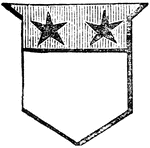
Chief Ordinary
"Argent, on a chief, gules, two mullets, sable. The chief is an ordinary terminated by an horizontal…
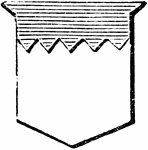
Chief Indented
"Argent, a chief, azure, indented. The chief is an ordinary terminated by an horizontal line, which,…
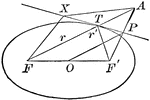
Tangent to an Ellipse
Diagram an ellipse with a tangent line that illustrates "A line through a point on the ellipse and bisecting…

Tangent to a Hyperbola
Diagram part of a hyperbola with a tangent line that illustrates "A line through a point on the hyperbola…
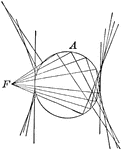
Construction of a Conic
Diagram showing how to construct a conic when given the focus and the auxiliary circle. If the focus…
Positioning Pen for Constructions
Illustration showing the correct and incorrect position of a right line pen against a T-square, triangle,…

Non-Vocal Primary Point Consonant
Consonants have a closed or narrowly expanded adjustment of the vocal organs, so that in their production…


